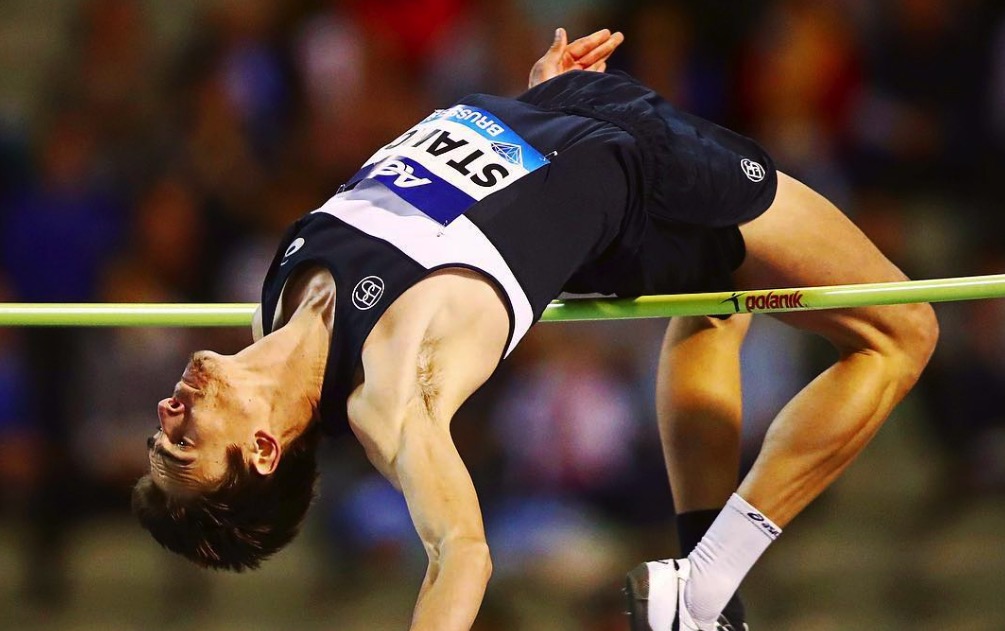Runner’s Tribe
It is a good time to be an emerging high jumper, an even better time to be Brandon Starc.
With the world champion Mutaz Essa Barshim sidelined by injury, and the handful of other men who have recently challenged 2.40 metres, and beyond, variously sidelined or not jumping similar heights, the second half of 2018 presented an opportunity for someone to take control of the event. How refreshing that the man to walk through that suddenly-open door was 24-year-old Australian Brandon Starc.
In the past few weeks, Starc has notched up his first Diamond League victory – in Birmingham on 18 August, with a then personal best 2.33; equalled Tim Forsyth’s 21-year-old national record with a further win in the high-jump Mecca of Eberstadt; and, last week (31 August), triumphed in the Diamond League final in Brussels with another victory at 2.33.
The Diamond League final win brought Starc a cash prize of $A70,000. I haven’t done the arithmetic, but that’s probably more in one hit than the paydays dotted here and there throughout his career until now. The cash train may have one more stop: Starc will be competing for the Asia-Pacific team in this weekend’s (8-9 September) IAAF Continental Cup in Ostrava. Event winners there will receive US$30,000, with prize awards down to eighth place.
The technicalities aside, there are (at least) two tricks to master in high jump. The first, jumping high, is easier than the second, which is jumping high at the right time in the big competitions. Starc seems to have mastered both elements: his first clearance at 2:30 was in the 2015 Sydney Track Classic, his first at 2.31 was in qualifying for the final at the world championships later that year in Beijing.
Starc needed ‘only’ a 2.29 to reach the Rio 2016 Olympic final, but he mastered 2.32 for the first time in taking the gold medal at the Commonwealth Games on the Gold Coast in April. His first clearance at 2.33 carried him to victory in Birmingham’s Diamond League meeting, his 2.36 equalled the national record Forsyth set in Melbourne on 2 March, 1997.
That performance came in Eberstadt, a small meeting in the sense it is high jump only, but prestigious among the vertical jumpers in the same wa iny Fukuoka, New York and London are amongst marathoners. This year was its 40th and, sadly, apparently its final edition. Starc is the only Australian winner, male or female.
Starc has drawn level with Forsyth on best height cleared, but he still has a way to go to match his co-national and Oceania record-holder’s achievements. Both did well at world junior competition, though Forsyth’s silver medals in 1990 and 1992 (losing out to a world U20 record both times), give him a substantial edge there.
Forsyth did not win a Commonwealth gold medal, but he has Olympic and world championship bronze medals to his name. He won the Olympic medal in Barcelona, 15 days short of his nineteenth birthday and the world bronze in Athens in 1997.
Forsyth also dominates on the numbers. He has nine of the 12 clearances by an Australian at 2.33 or higher, with Starc having the other three, all this year. Of the 44 clearances by an Oceania athlete at 2.30, or higher, Forsyth has a whopping 31, Starc is next at eight, Lochsley Thomson, a contemporary of Forsyth, has two and David Anderson, Jagan Hames and New Zealand’s Glenn Howard one each.
Forsyth cleared at least 2.30 outdoors every year from 1991 to 1999, inclusive. Starc has done it only in 2015 (twice) and 2018 (six, and counting).
But if Forsyth dominates the numbers, Starc is still accumulating achievements. One thing they have in common – Starc is the first Australian high jumper since Forsyth to regularly challenge the world’s best.
The Diamond Race format was changed last year so that the winners at the two finals took first place, rather than the top points scorers across the whole season. Starc is the only male Australian to win under the new format, joining Sally Pearson, who is the only female winner.
In addition to Starc’s strong finish to the year, 2018 has been a solid one for Australian vertical jumpers. Kurtis Marschall has established himself firmly among the group of emerging young male pole vaulters; and, though her year tapered off after the Commonwealth Games, Nina Kennedy had a best of 4.71 in the women’s vault, ranking her 13th in the world as the season nears its end.

















